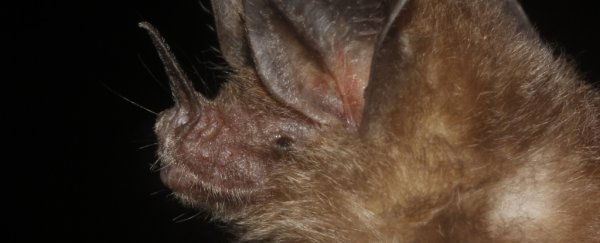The way bats use sound to locate their prey is even more clever than we thought. It turns out that leaf-nosed bats can even find insects that hide themselves from echolocation.
In what's known as acoustic camouflage, insects that sit motionless on leaves can be protected because the echo from the bat's cry bounces off the leaf at the same angle as the bug, effectively masking the insect's presence.
But that only happens if the sound waves hit the leaf dead on. If a bat approaches the leaf from an oblique angle, the mirror-like way the sound bounces reveals the insect to the hungry predator. And bats have figured this out.
It's a discovery that changes our understanding of how bats use echolocation - as well as interactions between predator and prey. And it may lead us to discover other ways in which bats compensate for the disadvantages of echolocation.
"For many years," said ecologist Inga Geipel of the Smithsonian Tropical Research Institute, "it was thought to be a sensory impossibility for bats to find silent, motionless prey resting on leaves by echolocation alone."
Bats' incredible echolocation skills are legendary. Rather than using eyesight for their hunting, as many nocturnal predators do, they make shrill cries and chirps that bounce off their surrounding environment as they fly.
This creates a three-dimensional map that bats use to hunt and navigate - the same principle is used for human technologies such as radar and LIDAR, using electromagnetic radiation instead of sound.
A flat leaf reflects the sound waves pretty strongly, so any insect sitting immobile on that leaf would be camouflaged by those reflected waves when approached from any angle at less than 30 degrees.
To figure out how the bats still manage to find the insects, Geipel and her colleagues collected a full hemispherical 3D echolocation profile of a leaf with and without resting prey. They bounced sound off the leaf from 541 positions around it in a hemisphere, for five different frequencies representing a bat's call.
From this, they found that, at an angle of greater than 30 degrees, sound bounces off a leaf on the same angle that it hits. This is called specular reflection, and it's a known property of mirrors - that's why, when you're at a high-enough angle, you don't see yourself.
 (Geipel et al., Current Biology, 2019)
(Geipel et al., Current Biology, 2019)
Then they put four wild-caught common big-eared bats (Micronycteris microtis) in an enclosure with some fake leaves, a motionless dragonfly and a bunch of cameras. Sure enough, the bats almost always approached the prey on the leaf from an oblique angle - the angle at which the insect would be detectable.
It's an ingenious solution. And it hints that bats might still have a few tricks up their little sleeves.
"Maybe there are other ways in which bats deal with the limitations of sonar," psychologist Dieter Vanderelst of the University of Cincinnati told Smithsonian Magazine.
"We might end up finding other behaviours in bats that deal with these shortcomings."
The research has been published in Current Biology.
